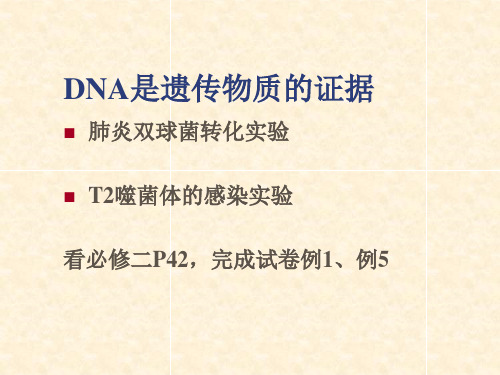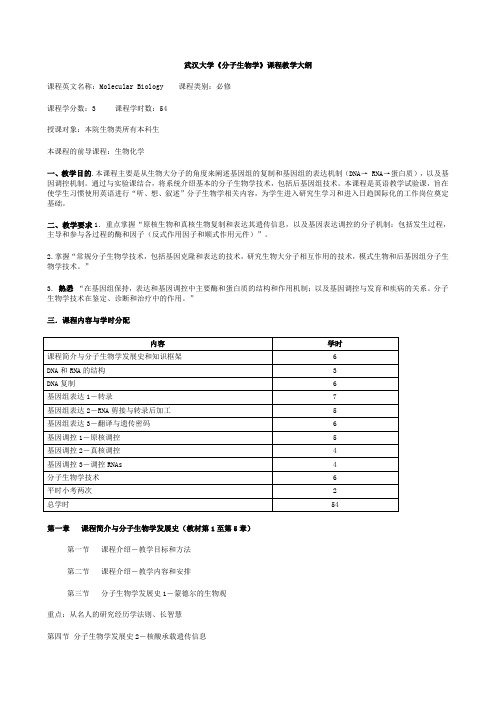武汉大学《基因的分子生物学》Section C
基因的分子生物学_图文PPT共70页

•
6、黄金时代是在我们的前面,而不在 我们的 后面。
•
7、心急吃不了热汤圆。
•
8、你可以很有个性,但某些时候请收 敛。
•
9、只为成功找好)。
•
10、只要下定决心克服恐惧,便几乎 能克服 任何恐 惧。因 为,请 记住, 除了在 脑海中 ,恐惧 无处藏 身。-- 戴尔. 卡耐基 。
谢谢你的阅读
❖ 知识就是财富 ❖ 丰富你的人生
71、既然我已经踏上这条道路,那么,任何东西都不应妨碍我沿着这条路走下去。——康德 72、家庭成为快乐的种子在外也不致成为障碍物但在旅行之际却是夜间的伴侣。——西塞罗 73、坚持意志伟大的事业需要始终不渝的精神。——伏尔泰 74、路漫漫其修道远,吾将上下而求索。——屈原 75、内外相应,言行相称。——韩非
武大分子生物学考研题库

武大分子生物学考研题库武大分子生物学考研题库分子生物学是现代生物学研究的重要分支,它研究的是生命的最基本单位——分子。
作为生物学考研的重要科目之一,分子生物学的题库对于考生来说是必备的学习资料。
下面将介绍一些武大分子生物学考研题库的内容和特点。
一、基础知识题1. DNA的结构是怎样的?请简要描述。
2. RNA的种类有哪些?它们分别在细胞中扮演什么角色?3. 请解释DNA复制的过程。
4. 什么是基因突变?请举例说明。
5. 请简述转录和翻译的过程。
这些基础知识题是考生必须掌握的内容,它们涵盖了DNA、RNA的结构和功能,以及基因突变、转录和翻译等基本概念。
考生需要通过深入学习和思考,掌握这些知识点,并能够灵活运用于解答题目。
二、实验设计题1. 请设计一种实验方法,用于检测某个基因在不同组织中的表达水平。
2. 请设计一种实验方法,用于检测某个蛋白质的亚细胞定位。
3. 请设计一种实验方法,用于研究某个基因在不同发育阶段的表达模式。
这些实验设计题旨在考察考生对实验设计的能力和创新思维。
考生需要结合自己的实验经验和理论知识,提出合理的实验方案,并能够解释实验的原理和预期结果。
三、综合应用题1. 请解释PCR技术的原理和应用。
2. 请简述RNA干扰技术的原理和应用。
3. 请简要介绍基因编辑技术CRISPR-Cas9的原理和应用。
这些综合应用题是将分子生物学的知识应用到实际问题中的考察。
考生需要综合运用所学的知识,理解和解释相关技术的原理和应用,并能够分析和讨论其优缺点及未来发展方向。
四、综合分析题1. 请分析某个基因在不同物种中的序列差异,并解释其可能的功能变化。
2. 请分析某个基因的突变与某种疾病的关联性,并提出可能的治疗策略。
这些综合分析题要求考生能够综合运用所学的知识,分析和解释实际问题,并提出合理的解决方案。
考生需要具备较强的分析思维和判断能力,能够将分子生物学的知识应用到实际问题中。
综上所述,武大分子生物学考研题库涵盖了基础知识题、实验设计题、综合应用题和综合分析题等多个方面。
分子生物学武汉大学历年试题(截至2022)

分子生物学武汉大学历年试题(截至2022)●实验设计题●分离基因、鉴定功能——PCR、电泳;敲除、高表达●验证核酸蛋白互作——ESMA、ChIP、DNA足迹法、酵母双杂交●大量表达基因/蛋白——基因工程:强启动子/诱导启动子、高拷贝质粒、偏爱密码子●选择实验原理+扩写●2001●名解●卫星DNA●复制体●逆转座子●反式激活因子●衰减子与衰减作用●问答●说出双链DNA复制起始有关的五种重要的酶或蛋白并简述它们的功能。
(15 分)●简述增强子的特点和性质及作用机制。
(10分)●简述真核RNA聚合酶II的转录起始复合物装配过程和转录起始 (15分)●DNA限制性内切酶EcoRI是人们熟悉的常用内切酶,它是在大肠杆菌(E.coli)R株中发现的,它被广泛用于分子克隆操作和DNA分析。
pUC质粒是常用克隆载体之一,它的多克隆位点上有EcoRI、BamHI、KpnI、HindIII 等酶切点。
假如要你把一段由EcoRI切割产生的外源DNA段克隆到 pUC 质粒中,并把重组质粒转化大肠杆菌R株来扩增,已知条件是所用的R菌株中只有EcoRI一种限制性内切酶,你设计如何做才能确保成功?为什么?(10分)●2002●问答●简述(或绘图说明)真核细胞RNA聚合酶II转录的起始需要哪些基本转录因子及其装配过程(15分)●简述(或绘图说明)色氨酸操纵子弱化的机制(15分)●在讨论基因家庭时经常提到胚胎、胎儿和成体形成的蛋白质,这些述语是指什么现象?可用什么术语来描述这一类基因家族(5分)●你正在进行 Southern blot 分析,并刚刚完成凝胶电泳部分,下一步是将胶浸泡在NaOH溶液中使DNA变性为单链,为了节约时间,你跳过这一步,直接把DNA 从胶上转到硝酸纤维素膜上,你将标记好的探针与膜杂交,却发现放射自显影结果是一片空白,哪里错了呢?(5分)●2003●名解●Domains and motifs 结构域与基序●Alternative splicing 选择性剪接●Reporter genes 报告基因●The PCR cycle 聚合酶链式反应循环●Restriction mapping 限制酶切图谱●Multiple cloning sites 多克隆位点●DNA libraries DNA文库●Proteomics 蛋白质组学●Replicon 复制子●Semi-conservative replication 半保留复制●简答●请列举三种以上蛋白质纯化技术,并说明不同纯化技术的简单原理。
基因与分子生物学23页PPT文档

DNA
I
mRNA
阻遏蛋白
pPol O Z Y A
启动转录
mRNA
β-半乳糖苷酶
半乳糖
乳糖
有乳糖存在时
谢谢!
xiexie!
谢谢!
xiexie!
五碳糖 结构
示意图
核苷酸 结构
示意图
空间结构
存在部位
一般为双链 主要存在于细胞核
单链 主要存在于细胞质
A
T
C
G
A
T
A
T
C
G
G
C
A
T
G
C
DNA分子的结构特点
(1)DNA分子是由两条 反向平行的脱氧核苷酸长 链盘旋成双螺旋结构。
A
T
C
G
A
T
A
T
C
G
G
C
A
T
G
C
DNA分子的结构特点
(1)DNA分子是由两条 反向平行的脱氧核苷酸长 链盘旋成双螺旋结构。
转录
• 场所:细胞核 线粒体 叶绿体 • 条件:模板 原料 酶 能量 • 方向:5-3 • 加工:剪切 戴帽 加尾
• 翻译的起始 • 翻译的延伸 • 翻译的终止
翻译
• 13、14、15、16、17、18、19、26、27、 28、29、30、31、32、33、34、35、36
基因的表达与调控
(一)原核细胞的基因结构 分为编码区、非编码区。
DNA的复制
• 场所:主要在细胞核、线粒体、叶绿体 • 时间:核在细胞分裂间期、质中的不一定 • 过程:边解旋边复制 • 特点:半保留方式(实验— 必修二P53) • 条件:模板 原料 能量 酶 • 11、12、25
分子生物学-武汉大学

刘青珍 武汉大学生命科学学院Biblioteka 第16章 原核生物的基因调控
本章内容
1. 本章概要 2. 转录调控的原理 3. 转录起始的调控:细菌中的实例 4. 实例 - λ 噬菌体的调控
3. 转录起始的调控:细菌中的实例
第三个例子 NtrC 和MerR: 通过变构而非招募起作用的激活子
在变构激活中 RNA聚合酶可以结合启动子 但形成的复合物没有转录活性 激活子引发复合物变构并激活转录
NtrC 有ATPase 活性 且从距基因较远处起作用
NtrC 控制参与氮代谢的基因表达 如 glnA 基因 有独立的激活域和DNA 结合域 只在氮水平低时与DNA 结合 诱导RNA聚合酶构象改变 引发从闭合式复合物向开放式复合物的转变
低氮水平- 信号 NtrC 磷酸化和构象改变 暴露DNA 结合区 NtrC 结合DNA 与结合在glnA 启动子上的 RNA聚合酶的54 直接互作 激活NtrC ATPase 活性,为 其聚合酶构象改变提供能量 转录开始
噬菌体Φ29 的P4 蛋白 抑制启动子的逃离 (在不同启动子中作用不同) 结合到强启动子PA2c:抑制 结合到弱启动子PA3:激活
抑制子以多种方式作用
抑制RNA 聚合酶与启动子结合:Lac 抑制子 抑制从闭合式复合物到开放的复合物的转变 E.coli Gal 抑制子 抑制启动子逃离 噬菌体Φ 29 P4 蛋白(在不同启动子中作用不同)
MerR 通过扭曲DNA 激活转录
MerR 控制merT 基因 它编码一种抗汞酶 在汞的存在下 MerR 结合到merT 启动子的﹣10 和﹣35 序列之间 的一段序列上 通过改变DNA 构象激活merT 表达
没有DNA 结合区和激活区的区分 结合与激活紧密相关
武大分子生物学考研历年真题

武大分子生物学考研历年真题对于许多立志在生物学领域深造的学子来说,报考武汉大学分子生物学专业的研究生是一个极具吸引力的选择。
而深入研究历年真题,无疑是备考过程中的关键环节。
武大分子生物学考研真题涵盖了丰富多样的知识点和题型。
从细胞生物学基础,到分子遗传学的原理,再到基因表达调控等诸多方面,都有深入且细致的考查。
在细胞生物学基础部分,真题常常涉及细胞的结构与功能、细胞的信号转导通路等内容。
例如,会要求考生阐述细胞膜的组成成分和结构特点,以及它们如何影响细胞内外物质交换和信息传递。
又或者,详细描述细胞内各种细胞器的功能,以及它们之间是如何协同工作以维持细胞正常生理活动的。
分子遗传学原理方面,真题可能会聚焦于 DNA 复制、转录、翻译的过程和机制。
比如,让考生解释 DNA 聚合酶在复制过程中的作用和特点,或者描述 RNA 聚合酶如何识别启动子并启动转录。
基因表达调控更是重点中的重点。
这部分真题可能会让考生分析不同层次的基因表达调控机制,包括转录水平、转录后水平、翻译水平和翻译后水平的调控。
例如,要求阐述转录因子如何结合到 DNA 上调控基因的表达,或者解释 microRNA 是如何通过影响 mRNA 的稳定性来调节基因表达的。
真题的题型也多种多样。
常见的有选择题,考查考生对基本概念和知识点的理解和记忆。
判断题则侧重于考察考生对一些易混淆概念的辨析能力。
简答题要求考生能够简洁明了地回答问题,展现对知识点的准确把握和概括能力。
论述题通常是综合性较强的题目,需要考生将多个相关知识点串联起来,进行深入的分析和阐述,以展现其对知识的系统理解和运用能力。
通过对历年真题的分析,可以发现一些出题的规律和趋势。
一方面,重点知识点会反复出现,只是考查的角度和形式可能有所不同。
另一方面,随着学科的发展和研究的深入,真题也会逐渐融入一些新的研究成果和前沿知识。
例如,近年来,随着基因编辑技术的迅速发展,真题中可能会出现与CRISPRCas 系统相关的题目,要求考生了解其原理和应用。
《分子生物学》3-section i -3-精选文档

2.
Library does not contain sufficient clones
Back
Size of library (ensure enough clones)
must contain a certain number of recombinants for there to be a high probability of it containing any particular sequence The formula to calculate the number of recombinants:
sequence from an organism each of which has been cloned into a vector for ease of purification, storage and analysis.
Gene library
Genomic libraries (made from genomic DNA)
ln (1-f) P: desired probability f : the fraction of the genome in one insert
N=
ln (1-P)
For example :for a probability of 0.99 with insert sizes
of 20kb these values for the E. coli (4.6×106 bp) and human (3×109 bp) genomes are :
Back
Genomic DNA libraries
eukaryotes Purify genomic DNA prokaryotes
武汉大学分子生物学2001—2015考研真题(1)

武汉大学2015年分子生物学武汉大学2014年分子生物学一.名词解释1、complementDNA2、RNAsplicing3、Gel filtration chromatography4、gene5、snRNP6、OKAZIKIN sequence7、operon8、enhancesome一.简答题1.从分子角度谈谈为什么DNA比RNA更广泛地用作遗传信息的携带者2.试说明中介蛋白在转录调控中的作用原理3.以下是DNA的电泳条带,说明DNA有哪三种拓扑异构构型?设计实验验证该结果。
4.翻译过程需要哪些组分?各自的功能分别是什么三.论述题1.CTD是RNAPOL2的末端结构,说明其结构特点。
它在转录各过程的作用是什么?2.试从产生过程,作用机制和生物学功能几个方面比较miRNA和siRNA的异同点3蛋白质A可以上调蛋白质B的表达水平,说明蛋白A可能在哪些水平发挥作用并设计实验证明。
武汉大学2013年分子生物学一、名词解释(共10小题,每题4分,共40分)1.Ribozyme2.Missense Mutation3.Insulator4.RNA trans-splicing5.Nucleotide excision repair6.Transposon7.Dam methylase8.Spliceosome9.Core promotor10. SNP二、简答题(共5小题,每题10分,共50分)1.真核生物mRNA的5’帽子结构有何生物学功能?其缺失会造成什么后果?2.某一基因开放阅读框中的一个碱基突变会对该基因编码产物产生什么影响?3.请简述真核生物的mRNA和原核生物的mRNA有何不同。
4.请简述Ⅰ型内含子剪切的过程.5.请简述Western blot 的原理和步骤。
三、论述题(共3小题,每题20分,共60分)1.研究基因功能通常是降低或升高基因表达水平,请简要说出三种相关研究方法及原理。
2. mRNA和蛋白质的降解是一个有序的过程,其中microRNA和泛素起了非常重要的作用,请简述microRNA的概念、产生过程、作用机制,或者泛素的概念和蛋白质泛素化的过程。
《分子生物学》课程教学大纲

武汉大学《分子生物学》课程教学大纲课程英文名称:Molecular Biology 课程类别:必修课程学分数:3 课程学时数:54授课对象:本院生物类所有本科生本课程的前导课程:生物化学一、教学目的.本课程主要是从生物大分子的角度来阐述基因组的复制和基因组的表达机制(DNA→ RNA→蛋白质),以及基因调控机制。
通过与实验课结合,将系统介绍基本的分子生物学技术,包括后基因组技术。
本课程是英语教学试验课,旨在使学生习惯使用英语进行“听、想、叙述”分子生物学相关内容,为学生进入研究生学习和进入日趋国际化的工作岗位奠定基础。
二、教学要求1.重点掌握“原核生物和真核生物复制和表达其遗传信息,以及基因表达调控的分子机制:包括发生过程,主导和参与各过程的酶和因子(反式作用因子和顺式作用元件)”。
2.掌握“常规分子生物学技术,包括基因克隆和表达的技术,研究生物大分子相互作用的技术,模式生物和后基因组分子生物学技术。
”3.熟悉“在基因组保持,表达和基因调控中主要酶和蛋白质的结构和作用机制;以及基因调控与发育和疾病的关系。
分子生物学技术在鉴定、诊断和治疗中的作用。
”三.课程内容与学时分配第一章课程简介与分子生物学发展史(教材第1至第5章)第一节课程介绍-教学目标和方法第二节课程介绍-教学内容和安排第三节分子生物学发展史1-蒙德尔的生物观重点:从名人的研究经历学法则、长智慧第四节分子生物学发展史2-核酸承载遗传信息重点:从重大发现学法则、开思路第五节化学弱相互作用与强相互作用决定大分子的结构第二章核酸结构(教材第6章)第一节 DNA的结构与拓扑异构酶重点:DNA的双螺旋结构与DNA的功能和复制之间的关系,以及DNA拓扑异构酶在解决细胞中DNA拓扑结构中的重要性第二节 RNA的结构与核酶重点:RNA可以折叠成高级结构的机制,不同核酶的结构与功能第三章 DNA复制(教材第8章)第一节 DNA复制的化学本质和DNA聚合酶的催化机制重点:DNA复制的化学反应,聚合酶的结构与催化第二节 DNA复制的过程-原核重点:不同蛋白因子是如何顺序性在复制过程中起作用的,先导链和滞后链复制的异同,不同DNA聚合酶的作用第三节 DNA复制的过程-真核重点:不同蛋白因子和聚合酶是如何顺序性在复制过程中起作用的,先导链和滞后链复制的异同第四节同一复制叉中先导链和滞后链同时被复制的机制重点:Sliding clamps和Clamp loader的作用,Trombone复制模型第五节 DNA复制起始的调控-普遍机制和原核机制重点:Replicator-initiator互作模型;E. coli的OriC,DnaA-ATP 水平,SeqA蛋白的作用第六节 DNA复制起始的调控-真核重点:Pre-RC (复制前复合物)的形成和调控第七节 DNA复制起始的结束重点:原核-II型拓扑异构酶的作用;真核-染色体复制的末端问题以及端粒酶的作用第四章基因表达1-转录(教材第12章)第一节 RNA聚合酶与转录循环内容:RNA聚合酶的种类和特征,RNA聚合酶催化的转录步骤,转录复合物在转录过程中的结构改变第二节细菌的转录循环1-启动子和因子第三节细菌的转录循环2-转录的起始,延伸和终止第四节真核转录1-RNA聚合酶II及其介导的前体mRNA转录起始重点:核心启动子的结构,以及普通转录因子组装起始复合物的过程其他内容:因为染色体高级结构的原因,体内转录需要Mediator复合物的作用第五节真核转录2-RNA聚合酶II转录的延伸重点:RNA聚合酶II CTD结构域所结合蛋白因子的顺序置换与前体mRNA的5'加帽,内含子剪接,3'加尾和转录终止第六节真核转录3-RNA聚合酶I和III转录rRNA和tRNA,小RNA的机制第五章基因组表达2-RNA剪接(教材第13章)第一节不同类型内含子分布和RNA剪接的化学性质第二节 I型和II型内含子核酶的剪接机制重点:结构和催化的化学反应第三节真核生物蛋白编码基因内含子的剪接-剪接体的组装,重排和催化重点:剪接体的组分(snRNPs);剪接体的组装、重派和催化之间的关系第四节可变剪接重点:生物学意义,调控机制第五节其他加工过程内容:选择性剪接体包含不同的snRNPs,RNA编辑,mRNA转运第六章基因组表达3-翻译与遗传密码(教材第14-15章)第一节 mRNA的功能内容:开放阅读框决定多肽序列,原核和真核mRNA上的翻译元件第二节转运RNA的功能,结构,以及氨基酸装载过程重点:氨基酸装载的识别功能第三节核糖内容:核糖体(翻译机器)组装与循环,翻译的化学特性,核糖体的催化功能。
武大分子生物学第三周-1

形成完整的核小体
核小体的组装
许多不依赖于DNA 序列的接触 介导核心组蛋白与DNA 的相互作用
组蛋白 N 端尾巴稳定缠绕八聚体的DNA
组蛋白尾巴从核小体特定位置伸出 指导DNA 以巴
用胰蛋白酶*处理核小体 能去除 N 端尾巴
而紧密包装的折叠域保持完整
蛋白酶 处理
*胰蛋白酶
特异性地在
带正电荷的氨基酸后切割
N 端尾巴(2)
是广泛修饰的位点 磷酸化、乙酰化、甲基化 在丝氨酸、赖氨酸、精氨酸残基上 这些修饰可改变单个核小体的功能
核小体的组装是一个有序的过程
首先,H3 和 H4 形成异源二聚体 然后,两个二聚体结合形成四聚体
第7章 基因组结构、 染色体、染色质和核小体
!!!!!!!
本章内容
1. 本章前言 2. 基因组序列和染色体多样性
3. 染色体的复制和分离 4. 核小体
5. 染色质的高级结构 6. 染色质结构的调控 7. 核小体的组装
4. 核小体
核小体是染色体的结构单位
真核细胞中大多数DNA 被包装进核小体
DNA 缠绕组蛋白核心储存负超螺旋
核心组蛋白 H2A、H2B、H3、H4(各两个拷贝)
核心DNA 缠绕其上
连接组蛋白 H1(单拷贝) 与连接DNA 结合
组蛋白的特性
带正电荷的氨基酸 超过20%的氨基酸:赖氨酸或 精氨酸
与带负电荷的DNA 作用 核心组蛋白相对较小:核心组蛋白11-15 kDa
连接组蛋白: 20 kDa
N 端尾巴
组蛋白折叠域
核小体由 8 个组蛋白所形成的核心和 缠绕在其上的DNA(核心DNA)组成
2001-2016年武汉大学885分子生物学考研真题及答案解析 汇编

2017版武汉大学《分子生物学》复习全书学长寄语2017版武汉大学《885分子生物学》考研复习全书是武汉大学高分已录取的学长收集整理的,全国独家真实、可靠,是真正针对武汉大学考研的资料。
我们将所有的资料全部WORD 化,高清打印。
真题编写了详细的答案解析,即使是小题也明确指出了考察的知识点,对于做题帮助更大。
同时,我们在分析历年考研真题的基础上,针对武汉大学考研,编写了详细的复习备考讲义,明确列出考研的重点、难点和考点,可在短时间内快速把握重点,提升成绩。
初试大家只需要准备我们的资料+教材+配套辅导书就足够了,不用再四处寻找其它资料。
学长现在就在武汉大学读研,跟大家一样也经历过考研。
不仅掌握了第一手的高参考价值复习资料,而且对于复习备考也有很多的经验、总结,大家报考武汉大学,有任何疑问均可以咨询我,能帮助大家的,我一定会尽力。
此外,我们还提供VIP一对一辅导,特别适合在职考研、二战、本科不好、基础较差的同学,可以在短时间内快速把握重点。
具体信息大家可以访问布丁考研网。
2017版武汉大学考研资料《分子生物学》考研复习全书(备考经验、真题及答案解析、高分版笔记)配套教材:[1]《现代分子生物学》(第四版),朱玉贤李毅著,高等教育出版社,2012[2]《遗传学》(分子遗传学部分),王亚馥戴灼华,高等教育出版社,1999[3]《Instant Notes in Moecuar Biology》,Turner P C、Mcennan A D、Bates A D、White M R H,科学出版社。
目录第一部分:备考篇 (1)一、武汉大学介绍 (1)二、武汉大学历年复试分数线 (3)1、2016年复试分数线 (3)2、2015年复试分数线 (4)3、2014年复试分数线 (4)三、报考难度分析 (4)四、备考方法与策略 (4)1、考研政治 (4)2、考研英语 (6)3、专业课复习方法 (8)第二部分:真题篇 (10)1、2016年武汉大学《分子生物学》考研真题 (10)2、2016年武汉大学《分子生物学》考研真题答案解析 (11)3、2015年武汉大学《分子生物学》考研真题 (17)4、2015年武汉大学《分子生物学》考研真题答案解析 (19)5、2014年武汉大学《分子生物学》考研真题 (26)6、2014年武汉大学《分子生物学》考研真题答案解析 (28)7、2013年武汉大学《分子生物学》考研真题 (35)8、2013年武汉大学《分子生物学》考研真题答案解析 (37)9、2012年武汉大学《分子生物学》考研真题 (46)10、2012年武汉大学《分子生物学》考研真题答案解析 (47)11、2011年武汉大学《分子生物学》考研真题 (53)12、2011年武汉大学《分子生物学》考研真题答案解析 (55)13、2010年武汉大学《分子生物学》考研真题 (63)14、2010年武汉大学《分子生物学》考研真题答案解析 (64)15、2009年武汉大学《分子生物学》考研真题 (73)16、2009年武汉大学《分子生物学》考研真题答案解析 (75)17、2008年武汉大学《分子生物学》考研真题 (85)18、2008年武汉大学《分子生物学》考研真题答案解析 (87)19、2007年武汉大学《分子生物学》考研真题 (95)10、2007年武汉大学《分子生物学》考研真题答案解析 (97)21、2006年武汉大学《分子生物学》考研真题 (105)22、2006年武汉大学《分子生物学》考研真题答案解析 (107)23、2005年武汉大学《分子生物学》考研真题 (115)24、2005年武汉大学《分子生物学》考研真题答案解析 (117)25、2004年武汉大学《分子生物学》考研真题 (127)26、2004年武汉大学《分子生物学》考研真题答案解析 (129)27、2003年武汉大学《分子生物学》考研真题 (139)28、2003年武汉大学《分子生物学》考研真题答案解析 (141)29、2002年武汉大学《分子生物学》考研真题 (153)30、2002年武汉大学《分子生物学》考研真题答案解析 (157)31、2001年武汉大学《分子生物学》考研真题 (163)32、2001年武汉大学《分子生物学》考研真题答案解析 (165)第三部分:2017版精品复习笔记(高分版) (171)第一章染色体与DNA (171)知识要点 (171)考点综述 (171)真题分析 (172)复习建议 (172)核心内容 (172)第二章遗传信息传递 (185)知识要点 (185)考点综述 (185)真题分析 (186)复习建议 (188)核心内容 (189)第三章基因表达调控 (220)知识要点 (220)考点综述 (220)真题分析 (221)复习建议 (224)核心内容 (225)第四章基因工程与蛋白质工程 (234)知识要点 (234)考点综述 (234)真题分析 (235)复习建议 (240)核心内容 (241)第五章系统生物学 (247)知识要点 (247)考点综述 (247)真题分析 (248)复习建议 (249)核心内容 (249)第六章病毒分子生物学 (260)知识要点 (260)考点综述 (260)真题分析 (260)复习建议 (261)核心内容 (261)第七章病毒与人类健康 (283)知识要点 (283)考点综述 (283)真题分析 (283)复习建议 (284)核心内容 (284)第八章常用的分子生物学实验技术 (291)知识要点 (291)考点综述 (291)真题分析 (292)复习建议 (294)核心内容 (294)第四部分诺贝尔奖专题 (313)2015年诺贝尔生理学或医学奖 (313)2014年诺贝尔生理学或医学奖 (313)2013年诺贝尔生理学或医学奖 (314)2012年诺贝尔生理学或医学奖 (315)2011年诺贝尔生理学或医学奖 (315)2010年诺贝尔生理学或医学奖 (318)2009年诺贝尔生理学或医学奖 (319)2008年诺贝尔生理学或医学奖 (319)2007年诺贝尔生理学或医学奖 (320)2006年诺贝尔生理学或医学奖 (322)2005年诺贝尔生理学或医学奖 (322)第五部分武汉大学《分子生物学》习题集 (325)第一部分:备考篇一、武汉大学介绍江城多山,珞珈独秀;山上有黉,武汉大学。
武汉大学分子生物学全部课程3

2020年7月18日星期六
•Molecular Biology of the Gene, 5/E --- Watson et al. (2004)
•Part I: Chemistry and Genetics •Part II: Maintenance of the Genome •Part III: Expression of the Genome •Part IV: Regulation •Part V: Methods
•Linking number is the number of times one strand have to be passed through the other strand in order for the two strands to be entirely separated from each other.
•Function (1): DNA in cells is negatively supercoiled; nucleosomes introduces negative supercoiling in eukaryotes
•Negative supercoils serve as a store of free energy that aids in processes that require strand separation, such as DNA
•It is a simple consequence of the geometry of the base pair.
•(See the Structural Tutorial of this chapter for details)
•
武汉大学分子生物学_chapter11 DNA的重组和转座

•Molecular Biology Course
Chapter 11 Site-Specific Recombination & Transposition of DNA
Although DNA replication, repair, homologous recombination occur with high fidelity to ensure the genome identity between generations,
This mechanistic feature contributes the “conservative” to the CSSR name, because every DNA bond that is broken during the reaction is resealed by the recombinase without consuming any external energy.
The general themes of site-specific recombination
1. All reactions depend critically on the assembly of the recombinase protein on the DNA and bring together of the two recombination sites
2. Some recombination requires only the recombinase and its recognition sequence for such an assembly; some requires accessory proteins including Architectural Proteins that bind specific DNA sequences and bend the DNA.
(武汉大学)分子生物学1_3章(一般不考)

(武汉大学)分子生物学1~3章(一般不考)●孟德尔学派的世界观●解释遗传性状如何从亲代传递给子代●law of segregation 独立分离定律(孟德尔第一定律)F2代中中显隐性性状的比率是3:1●在F1代表现的性状称为dominant 显性,而在F1代不表现的性状称为recessive隐性●不同的性状是由不同对遗传因子控制的(gene 基因)●law of independent 自由组合定律(孟德尔第二定律)F2 代中显性、两种杂合、隐性性状的比率是 9:3:3:1●当对多个性状进行检测时,子代中出现了具有重组性状的豌豆●homozygous 纯种——孟德尔成功的一个关键因素杂种:heterozygous●核酸承载遗传信息●DNA能够携带遗传物质——Avery发现●Griffith的肺炎双球菌转化实验——DNA可能是关键的遗传物质S细胞加热灭活之后与R细胞混合,生成了S细胞●Avery的实验——证明了DNA是遗传物质转化活性:脱氧核糖核酸酶(-) 核酸酶(+) 各种蛋白酶(+) 用核酸酶和蛋白酶处理:排除了RNA和蛋白质的污染●双螺旋——Watson & Crick●DNA半保留复制的证明●技术:放射性同位素标记、密度梯度离心、微量密度检测仪●过程:将大肠杆菌在只含有N15的培养基中培养若干代→ 后续的培养中,每代加入10倍的N14 → 利用E.coli的菌落数确定何时取样→ 进行密度定量检测●结果:N15-N15的条带转变为N15-N15的条带,最后转变为N14-N14和N15-N14条带能说明DNA复制不是全保留复制,但还不能排除分散复制的可能●附加实验:热变性处理实验——排除了分散复制的可能,确定了DNA半保留复制●原理:加热能使DNA解离变性●将培养一代的E.coli进行热处理并对N的同位素进行密度检测,如果密度峰值只有2个,即说明是半保留复制对照组:仅用15N培养基和仅用14N培养基培养的E.coli●中心法则——遗传信息的流向●包括DNA的复制、DNA的转录、RNA的翻译●修正补充:RNA的逆转录、RNA的复制、RNA的加工●蛋白质合成方向的确定通过三个实验完全证明了①肽链是顺序合成的、●实验一——证明肽链合成是顺序的●假设(原理)在加入放射性同位素标记的氨基酸之后,短时间内将溶液中已经合成完毕的球蛋白取出并酶解,测定每一个片段的放射性强度●核糖体合成●短时间标记:核糖体上有不同长度的肽链,加上的放射性氨基酸较少,酶切后测定出的每个肽链放射性强度差不多(没有明显放射性强度梯度)●长时间标记:越来越多的放射性氨基酸被掺入肽链,进行酶切处理时,越接近合成起始端,所带有的放射性氨基酸数目越多,放射性强度越强(放射性强度出现,并形成了起始端到末端逐渐减弱的梯度)●体外合成●短时间标记:位于肽链合成末端的放射性强度是最高的,越接近起始端放射性强度越低(从合成末端到起始端逐渐减弱的放射性强度梯度)●长时间标记:越接近合成的起始端,含有放射性氨基酸肽段的数目越多(削减肽链所产生的梯度)●过程●获得标记的球蛋白(细胞:兔网织红细胞,球蛋白:血红蛋白)兔网织红细胞中只合成血红蛋白,避免了杂蛋白的干扰 H3亮氨酸对球蛋白进行短时间标记,C14亮氨酸进行长时间标记●分离溶液中的球蛋白和核糖体上正在合成的球蛋白细胞破碎、离心,获得上清液和沉淀物。
- 1、下载文档前请自行甄别文档内容的完整性,平台不提供额外的编辑、内容补充、找答案等附加服务。
- 2、"仅部分预览"的文档,不可在线预览部分如存在完整性等问题,可反馈申请退款(可完整预览的文档不适用该条件!)。
- 3、如文档侵犯您的权益,请联系客服反馈,我们会尽快为您处理(人工客服工作时间:9:00-18:30)。
•Molecular Biology Course
C2 Chemical and Physical Properties of Nucleic Acids
1. Stability of Nucleic Acids 2. Effect of Acid & applications 3. Effect of alkali & applications 4. Chemical denaturation 5. Viscosity & applications 6. Buorant density & application
Nucleotides
A nucleotide is a nucleoside with one or more phosphate groups bound covalently to the 3’-, 5’, or ( in ribonucleotides only) the 2’-position. In the case of 5’-position, up to three phosphates may be attached. Phosphate ester bonds
•Molecular Biology Course
C1 Nucleic Acid Structure (DNA & RNA):
basesnucleosides nucleotide phosphodiester bonds primary sequence structure, modified nucleic acids
Conformational variability of RNA is important for the much more diverse roles of RNA in the cell, when compared to DNA.
Structure and Function correspondence of protein and nucleic acids
NUCLEOTIDES
Adenosine 5’-triphosphate (ATP) Deoxyadenosine 5’-triphosphate (dATP) Guanosine 5’-triphosphate (GTP)
Guanine (G) Guanosine
Deoxyguanosine
Deoxy-guanosine 5’-triphosphate (dGTP)
• Sugar-phosphate backbones (negatively charged): outside • Planner bases (stack one above the other): inside
back
3’
5’
C. Properties of nucleic acids
7 561 8 9 4 3 2
Thymine (T) is a 5-methyluracil (U)
C. Properties of nucleic acids C1 Nucleic Acid Structure (DNA & RNA):
Nucleosides
The bases are covalently attached to the 1’ position of a pentose sugar ring, to form a nucleoside
Protein
Nucleic Acids
Fibrous protein Globular protein Structural •Enzymes, proteins •antibodies, •receptors etc
Helical DNA Genetic information maintenance
Deoxynucleotides (containing deoxyribose)
Ribonucleotides (containing ribose)
C. Properties of nucleic acids BASES Adenine (A) NUCLEOSIDES
Adenosine Deoxyadenosine
4 32 1
A:T
G:C
Base pairing
back
C. Properties of nucleic acids
•Helical turn:
10 base pairs/turn 34 Ao/turn
back
C. Properties of nucleic acids
C1 Nucleic Acid Structure : RNA structure 1. Single stranded nucleic acid 2. Secondary structure are formed some time 3. Globular tertiary structure are important for many functional RNAs, such as tRNA, rRNA and ribozyme RNA
Forces for secondary and tertiary structure: intramolecular hydrogen bonding and base stacking.
tRNA
Ribozyme RNA
Secondary structure
Tertiary structure
C. Properties of nucleic acids
Chemical properties
Physical properties
back
C. Properties of nucleic acids
Stability of Nucleic Acids
1. Hydrogen bonding
• • Does not normally contribute the stability of nucleic acids or protein Contributes to specific structures of these macromolecules. For example, a-helix, b-sheet, DNA double helix, RNA secondary structure
supercoiling & energy, topoisomer & topoisomerase
C. Properties of nucleic acids C1 Nucleic Acid Structure (DNA & RNA):
Bases
Bicyclic Purines:
Monocyclic pyrimidine:
•Molecular Biology Course
SECTION C Properties of Nucleic Acids
The Race for the Double Helix (1994)
The diffraction pattern from the DNA optical transform slide shows the central cross pattern indicative of the helical arrangement of the strands of DNA. It also shows a missing 4th layer line which is the result of the two strands of the double helix being offset by 3/8 of a period. The strongly diffracting phosphorus atoms create the diamonds. The satelites above and below the cross are attributed to the base pairs.
attached phosphate groups 3’ end: free hydroxyl (-OH) group
Phosphodiester bond
C. Properties of nucleic acids
C1 Nucleic Acid Structure : DNA double helix
Globular RNA
•Ribozymes •Transfer RNA (tRNA) •Signal recognition etc.
C. Properties of nucleic acids
C1 Nucleic Acid Structure : Modified Nucleic Acids
Modifications correspond to numbers of specific roles. We will discuss them in some related topics. For example, methylation of A and C to can avoid restriction digestion of endogenous DNA sequence (Topic G3).
•Watson and Crick , 1953 •The genetic material of all organisms except for some
viruses
•The foundation of the molecular biology
C. Properties of nucleic acids
•Two separate strands Antiparellel (5’3’ direction) Complementary (sequence) Base pairing: hydrogen bonding that holds two strands together
